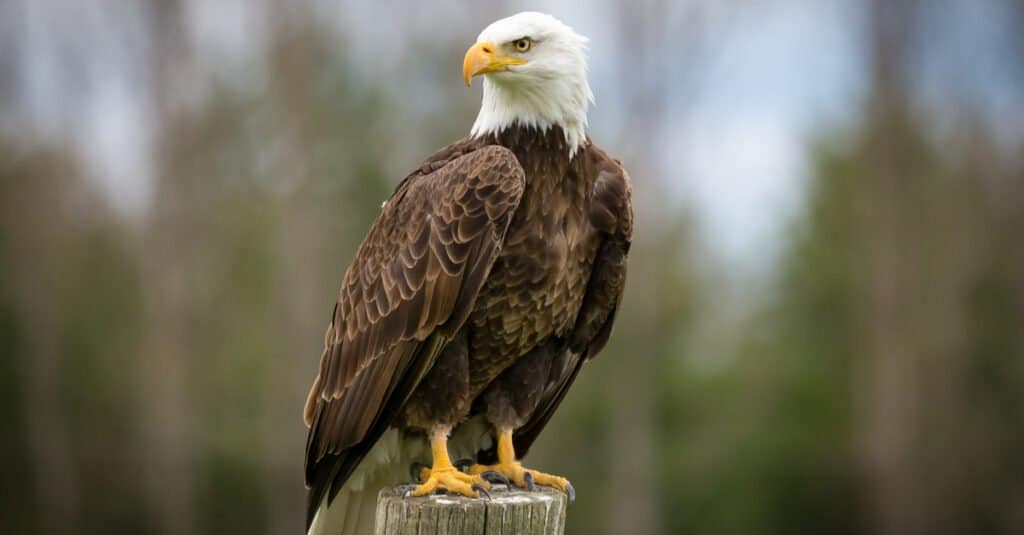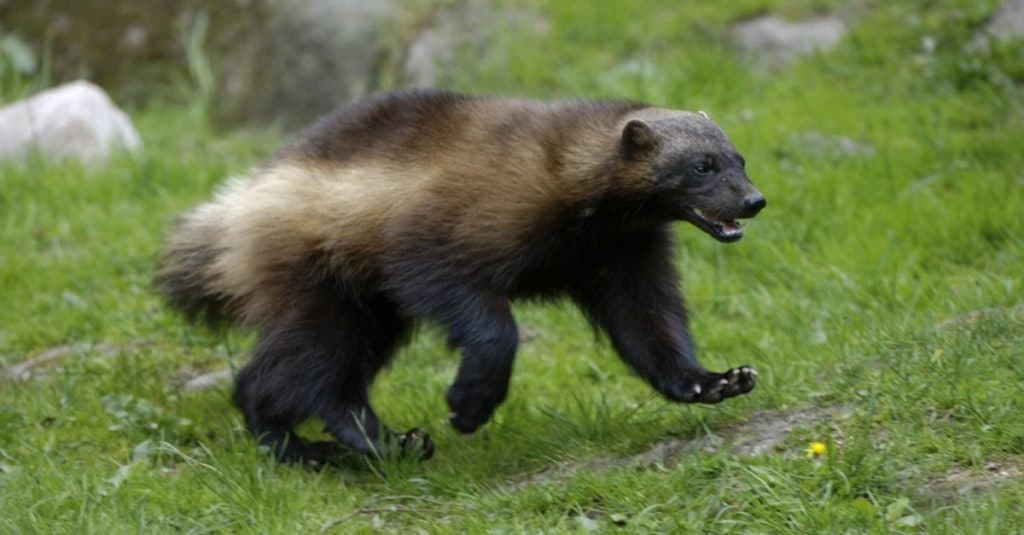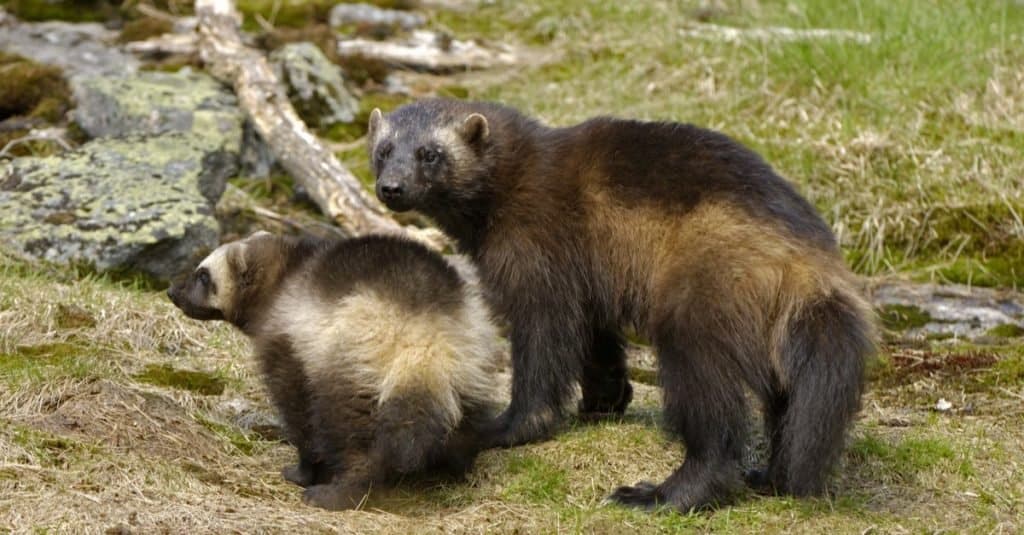Wolverines and bald eagles are two animals that are surrounded by myths and rumors that seem to multiply their strength and abilities. According to some people, a wolverine can take down a full-grown polar bear, while a bald eagle can supposedly take down wolves. Today, we’re going to use data to compare the two creatures and pit an epic battle between a bald eagle vs. a pack of wolverines.
We’ll show you precisely what each animal is capable of doing to the other and what would happen if a lone bald eagle swooped down on a wolverine only to realize it was not alone!
Comparing a Bald Eagle and a Pack of Wolverines

| Bald Eagle | Pack of Wolverines | |
|---|---|---|
| Size | Weight: usually from 6 to 14 pounds at their greatest weight Length: from 2.5 to 3.5 feet Wingspan: can reach about 7.5 feet | Weight: anywhere from 13 to 70 pounds Height: between 1 and 1.5 feet tall Length: grow between 2 and 3.5 feet long |
| Speed | – Regularly reaches 30 mph while flying – Maximum dive speed between 75 and 100 mph | – May run at speeds up to 30 mph |
| Defenses | – Their speed while flying makes it hard to catch eagles – The fact that they can take to the sky protects eagles from many predators – Their predatory senses let eagles detect danger from far away | – Has a thick layer of fur that can protect against some bites and slashes – The mammal’s ability to hide in small spaces would keep it safe – Large pack size could frighten off some predators |
| Offensive Capabilities | – Has a beak measuring up to 3 inches long that may be used to tear into prey – Has 8 talons measuring about 2 inches long – Has very strong grabbing power – Can only carry between 5 and 6 pounds at a time | – Attacks creatures by biting and clawing at vital areas – Has semi-retractable and curved claws used for digging and some climbing that can be used to attacking – Their bite force is somewhere between 50 and 150 PSI – Have specialized teeth help them tear through carrion, including 12 incisors and 4 long canine teeth |
| Predatory Behavior | – Bald eagles are ambush predators that attack while flying – May attempt to grab prey with one foot while attacking with the other | – More of a scavenger than a hunter – Will try to ambush animals to get an edge on them when hunting |
What Are the Key Differences Between a Bald Eagle and a Pack of Wolverines?
The key differences between a bald eagle and a pack of wolverines lie in their weight, morphology, and attacking methods. A wolverine is a mammal that can weigh from 13 to 70 pounds while standing 1.5 feet tall and growing about 3.5 feet long. They are mostly scavengers but can ambush prey from a hiding spot and bite at their vital organs until its dead.
Meanwhile, bald eagles are large birds that weigh between 6 and 14 pounds, grow up to 3.5 feet long, and have a wingspan of 7.5 feet at their utmost. These creatures are ambush predators that attack from the sky, often grasping prey and attacking it at the same time.
These major differences will have an impact on the outcome of this fight, giving the animals different advantages. However, we need to closely examine the data before concluding which creature or creatures win this fight.
What Are the Key Factors in a Fight Between a Bald Eagle and a Pack of Wolverines?
The most significant factors in this particular fight will be the size, methods of attack, and predatory behavior of each animal. We’re going to explore these factors and others to determine which animal has the most advantages in the battle. By the time we have finished looking at the five factors and assigning advantages, we’ll know which animal has the highest chance of surviving!
Bald Eagle vs. a Pack of Wolverines: Size
Given that we’re comparing a bird and a mammal, the dimensions of these creatures don’t match up that well. An individual wolverine is heavier than a bald eagle, weighing between 13 and 70 pounds compared to the bird’s 6 to 14 pounds. The bald eagle has a larger silhouette, growing 2.5 to 3.5 feet in body length while having a wingspan of 7.5 feet.
The weight of the wolverines gives them the advantage in this fight.
Bald Eagle vs. a Pack of Wolverines: Speed

Bald eagles are faster than wolverines in the air.
©iStock.com/emranashraf
The bald eagle is faster than a wolverine in the air, but a wolverine is faster than an eagle on the ground. The average bald eagle can dive at a speed of 75 to 100 mph, and it can maintain a typical flying speed of 30 mph. Meanwhile, wolverines can run at about 30 mph.
The start of this fight will give the bald eagle a speed advantage, but then it will rapidly shift to the wolverines.
Bald Eagle vs. a Pack of Wolverines: Defenses

The thick layer of fur protects wolverines from attack.
©Bildagentur Zoonar GmbH/Shutterstock.com
The bald eagle has one of the best defenses against terrestrial creatures: the ability to fly. They can simply fly away from most trouble. They do have to worry when they’re on the ground, though. They’re not particularly large or powerful on the ground compared to other animals. Still, their excellent hunting senses allow them to detect danger and react.
Wolverines have a thick hide and a thick layer of fur that protects them against some attacks. In this case, they also have their pack size.
Bald eagles have better defenses overall, but wolverines have better physical defenses.
Bald Eagle vs. a Pack of Wolverines: Offensive Capabilities
The bald eagle is a potent predator with several different methods of attack. It can swoop down and crash into its prey. Bald eagles can also grab their prey with their powerful feet and long, sharp talons. However, they can’t pick up and fly off with large animals. Instead, they can only lift about 6 pounds at a time, or they can’t take off.
Meanwhile, the wolverine relies on its semi-retractable claws, teeth, and relatively powerful bite force for a creature of its size to do damage. They don’t have a precise attack method. Instead, they attack by often diving at their prey and biting them in vital areas while clawing them until they’re dead.
The bald eagle’s precision in this case, gives them the advantage in the fight.
Bald Eagle vs. a Pack of Wolverines: Predatory Behavior
Wolverines are more likely to scavenge and forage than they are to hunt down creatures. They’ll eat carrion, and they can scare off other predators from their meals with their ferocity.
Yet, bald eagles are true hunters. They will swoop down and put an end to the fight before their prey knows what’s happening in many cases. However, if they miss their initial strike, it can be more difficult for the eagle to catch prey, especially if it’s fast prey.
Who Would Win in a Fight Between a Bald Eagle and a Pack of Wolverines?

The pack of wolverines would win the fight against a bald eagle every time.
©Bildagentur Zoonar GmbH/Shutterstock.com
A pack of wolverines would win a fight against a bald eagle. A bald eagle may be able to take out a single wolverine if it attacked from the sky and landed a good strike. Yet, once that bird is on the ground, it’s going to have some serious problems with the other four or so wolverines.
The wolverine’s preferred attack method is to use a flurry of bites and scratches along with their body weight to overwhelm their prey. If the Wolverines worked together, they could make the bald eagle succumb to injuries in short order.
If the wolverine aimed a bite at the bird’s head or a wing, it could ensure that the much lighter creature stays on the ground. That’s not to say the bird won’t fight back. With its large beak, strong feet, and talons, the bald eagle would try to fight off the mammals until it can get back in the air. The chances are that it won’t take flight again, though.
The wolverines could dog-pile the bird after its initial attack. The bald eagle can only take flight, holding between 4 and 6 pounds, much less than the average wolverine weighs. For all these reasons, the pack of wolverines would probably win this fight every time. That’s without going into the ferocity and determination of the average wolverine.
Who Could Beat a Pack of Wolverines in a Fight?
A battle between a pack of wolverines and another animal or group of animals is an interesting scenario to consider. While the wolverine’s strength and ferocity could prove to be a formidable challenge for any animal, some contenders may stand a chance against them. A grizzly bear, for instance, has immense strength and size that could give it an advantage in such a battle. Similarly, larger predators like lions or tigers have the power to take on multiple opponents at once. In terms of packs, wolves tend to travel in large numbers, which could make them difficult adversaries for the Wolverines. However, their size may leave them vulnerable if faced with several determined attackers at once. Ultimately, whether one pack would be able to defeat another depends heavily upon factors like each species’ natural strengths and weaknesses, as well as the environment they are fighting in.
Up Next:
- Epic Battles: The Largest Snake Ever vs. The Largest Lion
- Epic Battles: The Largest Eagle Ever vs. A Lion
- Epic Battles: 5 Bobcats vs. A Grizzly Bear
- Epic Battles: King Cobra vs. Wolf
The photo featured at the top of this post is ©
Sources
- Alaska Department of Fish and Game (1970) adfg.alaska.gov/index.cfm?adfg=wolverine.printerfriendly
Thank you for reading! Have some feedback for us? Contact the AZ Animals editorial team.






